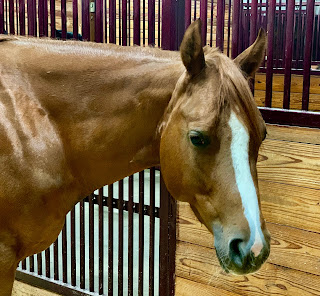Yesterday, Ginger had her surgery. The procedure on her left front leg involved severing her deep digital flexor tendon, which connects her coffin bone, (it's the pointed one on the bottom), to the muscle toward the top of her leg. When she foundered, the laminae, which normally keeps the bone in the proper place, gave way and the tension from the tendon pulled the bone back toward her heel. This rotation caused the bone to point down, shown in the before photo on the right. The procedure was done at Conley & Koontz Equine Veterinary Hospital outside of Ft. Wayne, Indiana by Dr. Ryan Rothenbuhler.
Ginger was sedated but not put to sleep. Instead she was standing throughout the surgery. Her lower leg was given a nerve block so she could not feel anything. An incision was made on the outside of her leg, about three inches above her foot and extending up about four inches. The doctor moves aside the exterior tendons to gain access to the deep digital tendon, which is about as thick as a human pinky finger. He cuts the tendon to release the tension. In Ginger's case, the tension was so significant that the gap between the severed tendon was about four inches. This allowed the bone to rotate forward, which you can see in the after photo on the left.
Ginger's incision was closed with five stitches and her leg was wrapped with sanitary wraps, then wrapped with gauze and finally wrapped with vet wrap to hold everything in place. She was given a long lasting antibiotic to prevent infection. She will get a second antibiotic injection on Monday, when our vet will replace the bandages and inspect the incision.
Now that was only half of the procedure. The second half, which is done immediately after surgery, is to fit her with a special shoe, the profile of which you can see in the x-ray on the left. The best way to describe it is a donut shoe with a wedge of about 6 degrees built into it. It is put on so the angle goes up from front to back. Her foot was packed with a cushioning compound, the heel was filed down significantly and the toe was pulled back then reshaped with epoxy. After 4 to 6 shoeings the goal is to have a normal shape to the hoof and a normal placement of the coffin bone in her foot. Our regular farrier attended the surgery and the shoeing so he could consult with the specialist shoer used by the clinic and he could also consult with the vet doing the surgery.
Ginger was given banamine for pain control on the trip home.
During the entire procedure, Ginger's foal, Ian, who is two weeks old, was being held by our assistant Natalie, while I was holding Ginger. The procedure, from beginning to end took about one hour and yet, he remained very patient and quiet. The few times he got excited, a quick scratch on the withers or the dock of the tail and he quieted right back down. I was very proud of him!
We left the farm at 11:15am, arrived at the clinic at 2:10pm, left the clinic at 4:30pm and got back home around 7:15pm. Today, we expected Ginger to be sore but she was remarkably comfortable and moving well in her stall. She is on stall rest for 30 days, to prevent the tendon from reconnecting. Exercise would stimulate this growth so we do not want her to get much exercise. This will be the biggest short term challenge because it means she will have the colt at her side constantly and he will need some excise and mental stimulation. Can you say jolly ball, beach ball, lick toys, etc.!
Today, he also got a second dose of plasma, just to make sure he is off to a good start and that he gets some protection from rhodococcus. So our vet came out to the farm today and with Natalie's help, gave the foal his plasma, and checked on Ginger. Our farrier was also at the farm and gave Ian his first trim, plus did the feet on the remaining horses.
If you ever go through this with your horses you can maybe learn from our experience. You have to make a choice. Ginger will never be ridden again but she can be made sound enough to have a full life. That is what we are trying to do. But it doesn't come cheap. Those of you with horses can add up the costs and you'll know what all of this will amount to. Less expensive options could have been tried and they may have worked and they may not have. The value of the mare, from a purely business perspective, is another factor. In Ginger's case, she's got that going for her because she's by Certain Potential and out of a mare by Invitation Only and out of Shesa Hot Cookie. It is impossible to duplicate these bloodlines and they represent some of the best bloodlines in the quarter horse world. The other thing is Ginger is a pleasant horse to be around, with normally good manners. If you want to do your horse a big favor, teach it manners so that people will want to work with it.
As we move on with her recovery I'll post x-rays and pictures so you can follow along.









